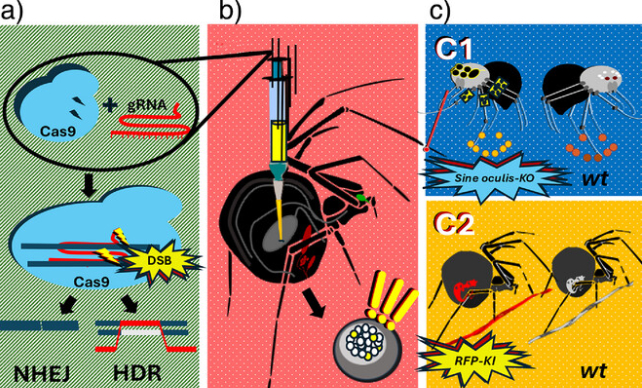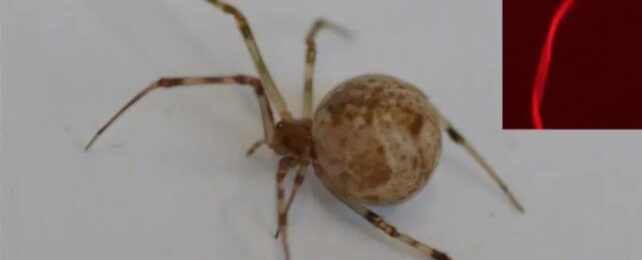Beginning a chain of events that will presumably lead to the origin of our universe's Spider-Man, researchers in Germany have created the world's first spiders to be genetically modified using CRISPR technology.
These spiders are unlikely to generate any superheroes (for now). They are not radioactive, and although their DNA has been altered, nothing has changed about their venom. They are still ordinary house spiders – mostly.
As a result of researchers' genetic modifications, some of the spiders lack eyes, while others gained the novel ability to spin fluorescent red silk.
If you're wondering how scientists did this, they used the gene-editing tool CRISPR-Cas9, which lets researchers cut into a cell's genome at specific locations and remove or insert sequences.
If you're wondering why they did this, it was largely a proof of concept. The researchers sensed an untapped potential – given the unique properties of spider silk, among other things – when they realized this gene-editing technology had not been applied to spiders.
"Considering the wide range of possible applications, it is surprising that there have been no studies to date using CRISPR-Cas9 in spiders," says senior author Thomas Scheibel, a biochemist at the University of Bayreuth.
Spiders are wonders of nature. They've achieved impressive evolutionary success, having existed for some 400 million years and diversified into more than 50,000 known species. They rank seventh in total species diversity among all orders of organisms.
Their silk is of particular interest. There are at least seven types among varieties of orb weaver alone, each with distinct attributes and uses by spiders. Some spider silks boast tensile strength comparable to steel, for example, but with peerless strength-to-weight ratios, not to mention elasticity and flexibility.
Humans have long sought to harness the magic of spider silk, but to little avail. Most spiders are territorial predators intolerant of company, preventing us from farming them like silkworms.
While synthetic spider silks are rapidly improving – now reportedly rivaling the original – there might still be unique value in learning to edit the genes for spider silk in vivo, the researchers contend.
Given the lack of precedent for gene editing with spiders, Scheibel and his colleagues started with a simpler goal of removing (or 'knocking out') a gene.
Hoping for clear results, they picked sine oculis, a gene involved with eye development.
The researchers then designed a version of the gene-editing system to fit their task, which was injected into the abdomens of anesthetized female spiders of the common house spider (Parasteatoda tepidariorum).
This CRISPR components acted upon the spider's egg cells, which when combined later with male DNA, gave rise to eye-less spiderlings.

Having established a process for genetic modification in house spiders, the next step was to tinker with silk genes. The researchers picked a gene for production of spidroins – the main proteins in spider silk – found in the strongest type of spider silk.
As in the previous experiment, they injected a targeted solution into female spiders, this time with a gene sequence for a red fluorescent protein.
Some spiderlings later spun red fluorescent dragline silk, providing evidence of a successful "knock-in" of the gene sequence into a silk protein.
"We have demonstrated, for the first time worldwide, that CRISPR-Cas9 can be used to incorporate a desired sequence into spider silk proteins, thereby enabling the functionalization of these silk fibres," Scheibel says.
"The ability to apply CRISPR gene-editing to spider silk is very promising for materials science research – for example, it could be used to further increase the already high tensile strength of spider silk."
The study was published in Angewandte Chemie.
